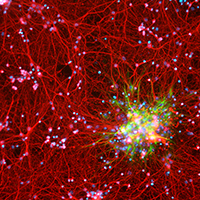Quantitative, structural and molecular changes in neuroglia of aging mammals: A review

Accepted: 27 May 2021
HTML: 11
All claims expressed in this article are solely those of the authors and do not necessarily represent those of their affiliated organizations, or those of the publisher, the editors and the reviewers. Any product that may be evaluated in this article or claim that may be made by its manufacturer is not guaranteed or endorsed by the publisher.
Authors
The neuroglia of the central and peripheral nervous systems undergo numerous changes during normal aging. Astrocytes become hypertrophic and accumulate intermediate filaments. Oligodendrocytes and Schwann cells undergo alterations that are often accompanied by degenerative changes to the myelin sheath. In microglia, proliferation in response to injury, motility of cell processes, ability to migrate to sites of neural injury, and phagocytic and autophagic capabilities are reduced. In sensory ganglia, the number and extent of gaps between perineuronal satellite cells – that leave the surfaces of sensory ganglion neurons directly exposed to basal lamina– increase significantly. The molecular profiles of neuroglia also change in old age, which, in view of the interactions between neurons and neuroglia, have negative consequences for important physiological processes in the nervous system. Since neuroglia actively participate in numerous nervous system processes, it is likely that not only neurons but also neuroglia will prove to be useful targets for interventions to prevent, reverse or slow the behavioral changes and cognitive decline that often accompany senescence.
How to Cite
PAGEPress has chosen to apply the Creative Commons Attribution NonCommercial 4.0 International License (CC BY-NC 4.0) to all manuscripts to be published.
Similar Articles
- Peng Lin, Boliang Zhou, Haiying Yao, Ya-ping Guo, Effect of carboplatin injection on Bcl-2 protein expression and apoptosis induction in Raji cells , European Journal of Histochemistry: Vol. 64 No. 3 (2020)
- Roman M. Kassa, Roberta Bonafede, Federico Boschi, Manuela Malatesta, Raffaella Mariotti, The role of mutated SOD1 gene in synaptic stripping and MHC class I expression following nerve axotomy in ALS murine model , European Journal of Histochemistry: Vol. 62 No. 2 (2018)
- G Bottiroli, AC Croce, MG Bottone, S Vaccino, C Pellicciari, G0-G1 cell cycle phase transition as revealed by fluorescence resonance energy transfer: analysis of human fibroblast chromatin , European Journal of Histochemistry: Vol. 48 No. 1 (2004)
- N Sjakste, T Sjakste, Possible involvement of DNA strand breaks in regulation of cell differentiation , European Journal of Histochemistry: Vol. 51 No. 2 (2007)
- Carlo Alberto Redi, Protein expression in mammalian cells: methods and protocols , European Journal of Histochemistry: Vol. 56 No. 3 (2012)
- D. Martini, A. Trirè, L. Breschi, A. Mazzoni, G. Teti, M. Falconi, A. Ruggeri Jr, Dentin matrix protein 1 and dentin sialophosphoprotein in human sound and carious teeth: an immunohistochemical and colorimetric assay , European Journal of Histochemistry: Vol. 57 No. 4 (2013)
- Rosa Manca, Chester Glomski , Alessandra Pica, Hematopoietic stem cells debut in embryonic lymphomyeloid tissues of elasmobranchs , European Journal of Histochemistry: Vol. 63 No. 3 (2019)
- A. Bonetti, A. Bonifacio, A. Della Mora, U. Livi, M. Marchini, F. Ortolani, Carotenoids co-localize with hydroxyapatite, cholesterol, and other lipids in calcified stenotic aortic valves. Ex vivo Raman maps compared to histological patterns , European Journal of Histochemistry: Vol. 59 No. 2 (2015)
- G. Radaelli, C. Poltronieri, C. Simontacchi, E. Negrato, F. Pascoli, A. Libertini, D. Bertotto, Immunohistochemical localization of IGF-I, IGF-II and MSTN proteins during development of triploid sea bass (Dicentrarchus labrax) , European Journal of Histochemistry: Vol. 54 No. 2 (2010)
- Elena Pompili, Viviana Ciraci, Stefano Leone, Valerio De Franchis, Pietro Familiari, Roberto Matassa, Giuseppe Familiari, Ada Maria Tata, Lorenzo Fumagalli, Cinzia Fabrizi, Thrombin regulates the ability of Schwann cells to support neuritogenesis and to maintain the integrity of the nodes of Ranvier , European Journal of Histochemistry: Vol. 64 No. 2 (2020)
<< < 48 49 50 51 52 53 54 55 56 57 > >>
You may also start an advanced similarity search for this article.

 https://doi.org/10.4081/ejh.2021.3249
https://doi.org/10.4081/ejh.2021.3249










